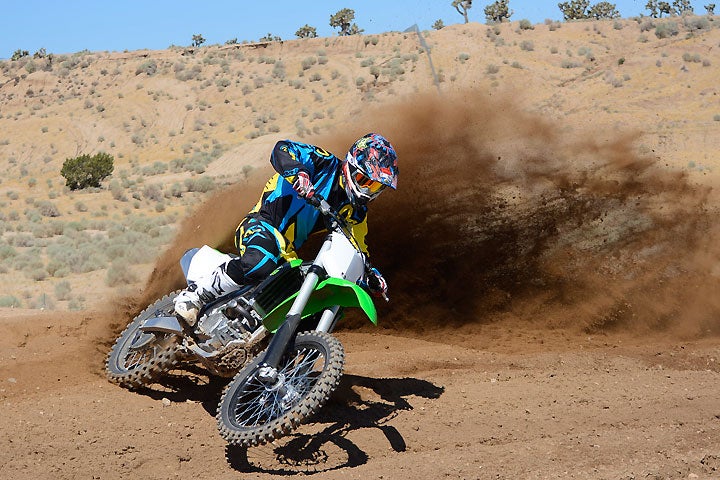
Motocross bike development could perhaps best be likened to a pendulum, and for 2017 the Kawasaki KX250F is clearly on the upswing.
After undergoing only minor revisions last year, the 2017 KX250F features a host of changes that bring it up to speed with its big sister, the KX450F. Following in the 450’s tire tracks, the KX250F’s new frame and swingarm, new engine, new radiators, major suspension revisions and new bodywork mean that it shares very little in common with its predecessor, and yet the KX250F still won’t be mistaken for anything other than a KX250F on the track.
So is that a good thing or a bad thing?
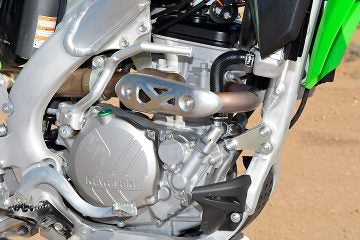 Starting with the engine, Kawasaki gave the KX250F’s 249cc, liquid-cooled, fuel-injected, DOHC, four-valve Single a makeover by incorporating new cases with an offset cylinder that is moved a few millimeters forward to free up more power by reducing piston sidewall thrust, which decreases drag. Kawasaki engineers also revised the KX’s bridged-box piston to shave a few grams after weight was added to the piston when it was redesigned for 2016. The KX250F’s 13.7:1 compression is .1 of a point lower than the 2016 KX250F’s while its 77.0 x 53.6mm bore and stroke is identical.
Starting with the engine, Kawasaki gave the KX250F’s 249cc, liquid-cooled, fuel-injected, DOHC, four-valve Single a makeover by incorporating new cases with an offset cylinder that is moved a few millimeters forward to free up more power by reducing piston sidewall thrust, which decreases drag. Kawasaki engineers also revised the KX’s bridged-box piston to shave a few grams after weight was added to the piston when it was redesigned for 2016. The KX250F’s 13.7:1 compression is .1 of a point lower than the 2016 KX250F’s while its 77.0 x 53.6mm bore and stroke is identical.
Deeper inside the KX’s bowels is a new connecting rod that features a plain bearing instead of the needle bearing that was used previously. Plain bearings are simpler in design, lacking the moving parts found in a needle bearing, which helps durability and reduces maintenance needs.
Kawasaki also addressed the KX250F’s power needs by attempting to improve airflow through the engine. A new downdraft-style intake that allows the incoming air to get a better run toward the intake valves. The KX’s 43mm Keihin DFI dual-injector throttle body also gets a new downstream injector that features twice as many holes for better fuel atomization. This was done to improve throttle response and provide better low-to-midrange power. On the exhaust side, Kawasaki altered the KX’s exhaust camshaft specs and also went with a shorter and smaller header. The engine also receives revised cam sprockets and a new cam chain. Aside from its basic aluminum perimeter design, the 2017 KX250F’s chassis shares little with the 2016.
We put the 2017 KX250F through its paces at two tracks in Southern California’s high desert. DBC test riders Ryan Abbatoye and Nic Garvin spun numerous laps at Competitive Edge and Sunrise MX Park, giving us a solid impression of how well the new KX works when compared to the previous model.
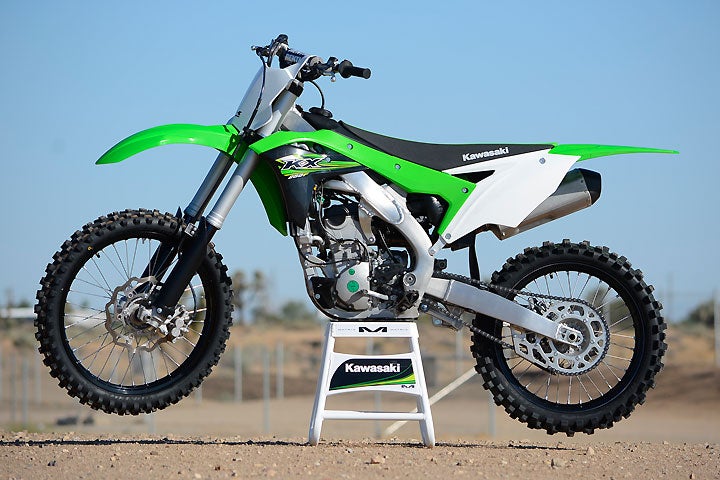
Swinging a leg over the 250F’s new rail-thin chassis (more on that in a moment), we appreciated just how easy the engine comes to life with only a half-hearted stab at the kickstart lever. The Keihin DFI’s throttle response is excellent, with a few blips of the throttle projecting a hearty rumble from the KX’s aluminum muffler. After getting comfortable with the bike, Abbatoye dropped the hammer.
Last year’s KX250F focused heavily on the mid-range power, and the 2017 model does as well. The new KX’s engine performance, while very good, could still use more grunt down low and more thrust on top. Abbatoye felt that he had to rev the KX250F pretty hard to clear some of Comp Edge’s bigger jumps.
The key to fast lap times on the KX still lies in keeping its rev-happy engine singing in the middle and upper rpm while rowing its smooth and precise five-speed gearbox to get the best drive out of corners.
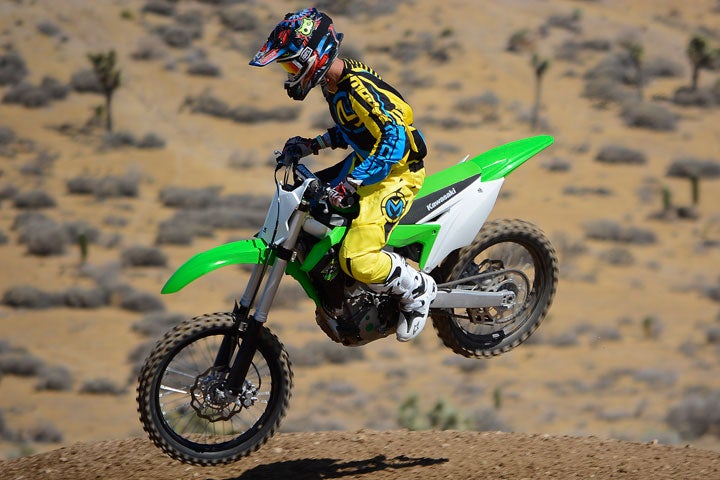
“It’s a mid-range to top-end motor, and that’s where you have to keep it to go fast on it,” Abbatoye said.
After we spent some more time on the track, Kawasaki technician Mike Chavez recommended that we try swapping the KX’s stock 50-tooth rear sprocket for a 51 to help the KX bark into the midrange a little sooner. Big difference! The added tooth helped to tighten up the transition from low-end into KX’s decent midrange hit, and although the motor still flattens out on top earlier than we’d like (and who doesn’t want more top-end power from a 250?), Abbatoye found that he was able to hold gears longer on the long, fast and sandy Comp Edge track.
Kawasaki then had one more trick up its sleeve in the form of an ECU coupler that had been flashed specifically for its 2017 KX250F intro at Zaca Station. Like most four-stroke motocrossers nowadays, the KX’s power can be tailored at the track by swapping DFI couplers that will access one of three maps in the KX’s ECU. Each KX comes with three color-coded couplers tuned for hard, medium or soft track surfaces, but the couplers can also be customized via Kawasaki’s accessory handheld KX FI Calibration Kit, which allows the rider to store and select from up to seven separate engine maps.
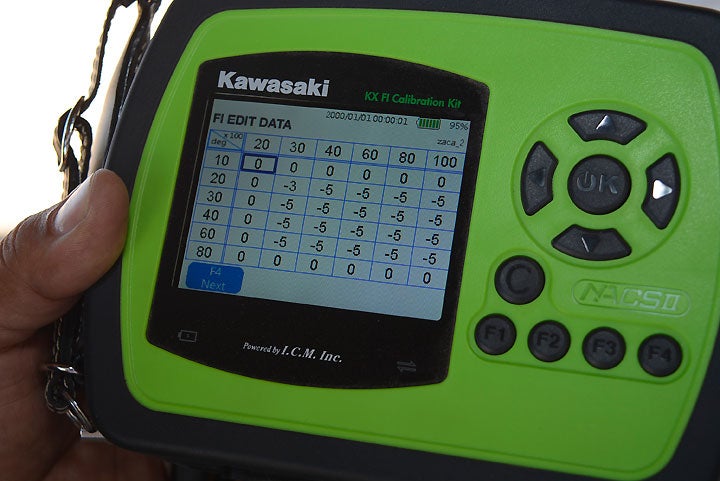
With the custom-mapped coupler, the KX came alive even more, giving the KX an even sharper hit and a more robust feel at higher rpm. We made sure to photograph the custom coupler’s settings as seen on the hand-held accessory FI calibration unit for anyone who wants to give them a try.
“The stock ‘aggressive’ coupler didn’t make a drastic change, but the custom map made the engine perform a lot better,” Abbatoye said. “With that and the 51-tooth sprocket, it’s a step in the right direction as far as what Expert- and Pro-level riders would be looking for.”
The changes meant less tap-dancing on the shifter as the KX250F pulled strongly into the middle and offered better overrev, although both Abbatoye and Garvin still felt that the KX’s torque flattens out noticeably on top (and who doesn’t want more top-end thrust from any 250cc four-stroke?). We’d recommend the custom mapping for most riders, as even our vet and novice riders appreciated the change in power character, which helps to increase rider confidence when tackling jumps or other obstacles on the track.
But whether you shift a lot or a little, the KX250F’s cable-operated clutch and five-speed transmission deliver an excellent feel and precise shifting. Kawasaki revised the shift forks and the gear-change mechanism for 2017 with the goal being better shifting performance. We didn’t have any issue with the 2016 transmission’s performance, and we certainly don’t with the 2017’s either.
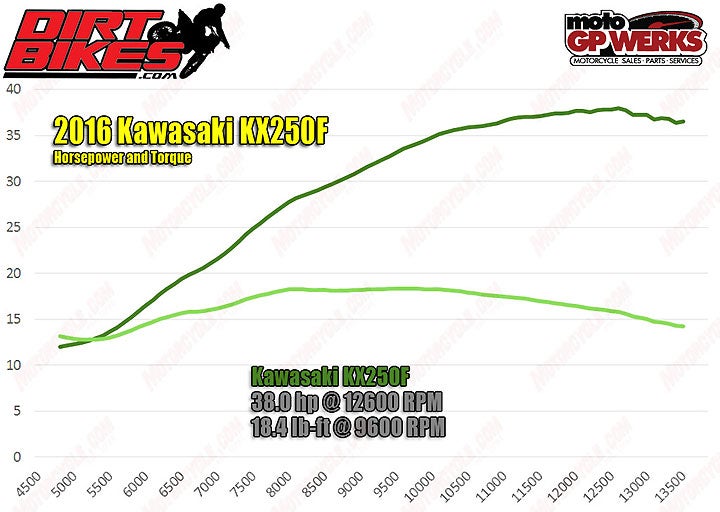
Placing our KX250F on the Dynojet dyno at MotoGP Werks of Anaheim, California, confirmed our seat-of-the-pants impressions. The dyno showed that the KX250F delivers a solid 38 rear-wheel horsepower at 12,600 rpm with its peak torque output of 18.40 lb.-ft. occurring at 9600 rpm. The good news is that the 2017 KX250F doesn’t exactly fall on its face after that—like the 2016 did—but it is noticeable.
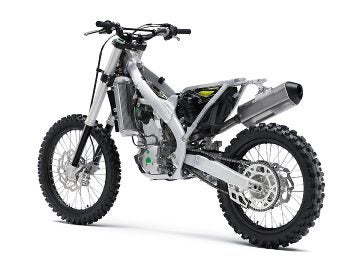 The improvements made to the 2017 KX250F’s handling and suspension are profound and even more positive. Aside from its basic aluminum perimeter design, the 2017 KX250F’s chassis shares little with the 2016. Kawasaki’s goal was to put the 250F on a serious diet, and its all-new chassis shaves 3.75 pounds off the total package while also being narrower and more rigid than the 2016 model. A new front downtube and 3mm narrower main beams reduce its overall width by 6mm. Wheelbase checks in at 58.1 inches, same as the 2016, although the rake is .2 of a degree tighter, now 25.5 degrees, while retaining the same 5-inch trail as the 2016. On our scales, with its 1.69-gallon fuel tank filled to capacity, the KX250F weighed 233 pounds, placing 48.5 percent of its weight on the front wheel and 51.5 percent on the rear wheel.
The improvements made to the 2017 KX250F’s handling and suspension are profound and even more positive. Aside from its basic aluminum perimeter design, the 2017 KX250F’s chassis shares little with the 2016. Kawasaki’s goal was to put the 250F on a serious diet, and its all-new chassis shaves 3.75 pounds off the total package while also being narrower and more rigid than the 2016 model. A new front downtube and 3mm narrower main beams reduce its overall width by 6mm. Wheelbase checks in at 58.1 inches, same as the 2016, although the rake is .2 of a degree tighter, now 25.5 degrees, while retaining the same 5-inch trail as the 2016. On our scales, with its 1.69-gallon fuel tank filled to capacity, the KX250F weighed 233 pounds, placing 48.5 percent of its weight on the front wheel and 51.5 percent on the rear wheel.
The difference in chassis feel when seated on the 2017 KX250F is immediately noticeable. This thing feels like a bicycle! Its new seat is slimmer and flatter before, and its new fuel tank, which features a 20mm shorter gas cap height, contribute to the ease with which a rider can climb around on the KX250F. We’re also big fans of Kawasaki’s move to place the KX’s new radiators in a V-shape, further slimming the ergos and making it all but impossible to catch a boot or a knee guard on the KX’s compact radiator shrouds. The KX retains Kawasaki’s Ergo-Fit upper triple clamp, which features two sets of handlebar mount slots to allow up to four handlebar positions—25mm forward, 15mm forward, standard or 10mm rearward. The KX’s footpeg brackets are also adjustable to two different positions. If you can’t tailor the fit of the KX to match your tastes, you’re either built like Shaquille O’Neal or Mini-Me.
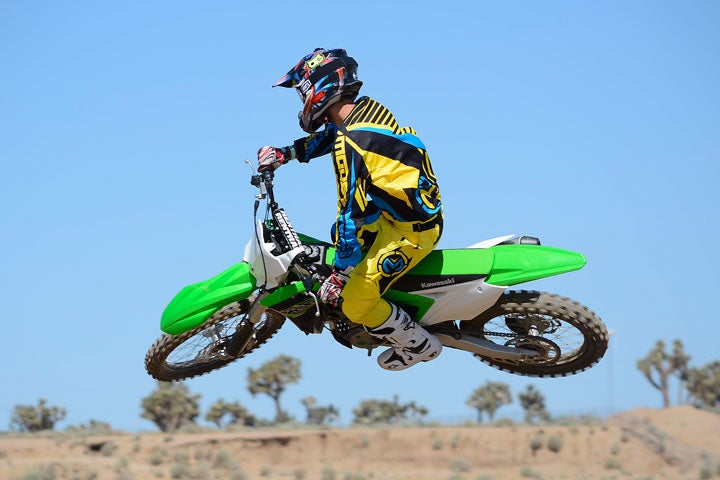
Last year, we noted that the KX250F possessed excellent straight-line stability at all speeds but its steering was a little heavy-handed, which made mid-corner line changes a little more challenging. The new chassis is a big improvement, although initially we noticed that it still wanted to push wide on flat ground. However, all it took to change that character was to swap to the 51-tooth sprocket, which also happened to move the rear axle about 5mm closer to the chassis center line. The difference was night and day. While the new KX’s steering still isn’t the lightest in the class, it’s much better than the 2016.
Overall, the steering is light and neutral, and the 2017 will hold a line and change direction much easier than its predecessor. With the wheelbase adjustment, the chassis is slightly less settled at higher speeds than the 2016, but the Kawasaki is still plenty stable anyway. It’s a tradeoff we’re happy to make.
We were already fans of the KX250F’s 48mm Showa SFF fork (not an air fork—yay!) and Showa-suspended Uni-Trak rear suspension, and for 2017 the good has gotten even better. We’ve always liked the fact that the SFF places a 40-way spring preload adjuster along with the 22-position compression and 20-position rebound damping adjusters. The preload adjuster is an excellent tool to have when dialing in the fork, which has a 9.8 N/mm spring rate. We left our fork tube height at the stock 5mm above the top clamp and didn’t even mess with the stock compression and rebound settings, which were left at eight turns out from full compression and 16 turns out from full rebound. All we did was back the preload off four turns. One quick note here: The preload adjuster is turned clockwise to slack off the load on the spring.
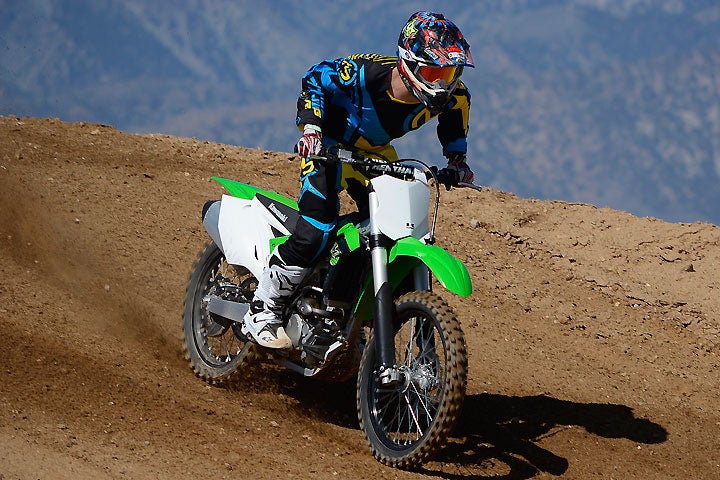
Out back, Kawasaki fitted the 2017 KX250F with a new swingarm, revised linkage ratios for the Uni-Trak and revised settings in the Showa piggyback shock, which is fitted with a new 52 N/mm spring. The shock features 19 positions of adjustment for low-speed compression four turns of adjustment for high-speed compression damping, along with 22 positions for rebound damping. Once Abbatoye dialed in the fork, he stuck with the stock shock settings, which included 11 turns out on the low-speed adjuster, 2.5 turns out on the high-speed and 10 turns out on the rebound adjuster.
The reward for this minimal fiddling is a bike with an excellent 12.2 inches of front and rear suspension travel. The KX250F tracks through large and small bumps with a supple feel while resisting bottoming over large jumps. It certainly does not blow through the suspension travel as quickly as its big sister does, and that’s a good thing. Some testers reported the odd kick off of the occasional bump, but the Kawasaki’s chassis was unfazed. The Kawi’s suspension could easily challenge for top honors in 250-dom.
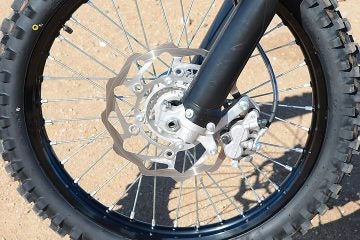 The KX250F might also have the best brakes in the 250cc class. Up front, a semi-floating 270mm Braking petal disc and two-piston caliper deliver warp-killing pucker power without being touchy or spongy, and it’s more of the same with the 240mm Braking disc and single-piston caliper that brings up the rear. The KX is blessed with excellent binders that are strong and very easy to modulate.
The KX250F might also have the best brakes in the 250cc class. Up front, a semi-floating 270mm Braking petal disc and two-piston caliper deliver warp-killing pucker power without being touchy or spongy, and it’s more of the same with the 240mm Braking disc and single-piston caliper that brings up the rear. The KX is blessed with excellent binders that are strong and very easy to modulate.
One thing we didn’t care for had to with the KX’s sleek new bodywork. We love how it looks, and we appreciate that Kawasaki went with In-Mold graphics that are impregnated in the plastic to keep the KX looking fresh longer, we noticed that our test unit started to look a little ragged from boot wear marks on the plastic after just a couple rides. On the plus side, the black treatment on the KX’s Excel rims and on its fork leg protectors give the Kawi a racy, works bike-inspired look.
For 2017, you can get a Kawasaki KX250F that is a lot different and, in many ways, a lot better than the 2016. It sports better engine performance (even better yet with our recommended ECU mod), a much slimmer, lighter and better-steering chassis, excellent suspension and awesome brakes. Best of all, this new trickery comes at an MSRP of $7749, just $150 more than the 2016 model. That increase doesn’t reflect the full degree of improvement in the KX250F, a strong performer with signature Kawasaki traits that make it a great bargain in the 250cc motocross class for 2017.
And to answer our initial question, that’s a very, very good thing.
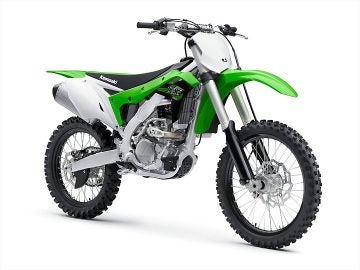 2017 Kawasaki KX250F Specifications
2017 Kawasaki KX250F Specifications
Engine: 4-stroke, 1-cylinder, DOHC, water-cooled
Displacement: 249cc
Bore x Stroke: 77.0 x 53.6mm
Compression Ratio: 13.7:1
Fuel System: DFI® with 43mm Keihin throttle body and dual injectors
Ignition: Digital DC-CDI
Transmission: 5-speed
Final Drive: Chain
Front Suspension: 48mm inverted Showa SFF telescopic fork with 40-way spring preload adjustability and 22-position compression and 20-position rebound damping adjustability, 12.2 inches of travel
Rear Suspension: Uni-Trak linkage system and Showa shock with 19-position low-speed and 4-turns high-speed compression damping, 22-position rebound damping, fully adjustable spring preload, 12.2 inches of travel
Front Tire: 80/100-21 Dunlop MX3S
Rear Tire: 100/90-19 Dunlop MX3S
Front Brake: Single semi-floating 270mm Braking petal disc with dual-piston caliper
Rear Brake: Single 240mm Braking petal disc with single-piston caliper
Frame: Aluminum perimeter with aluminum subframe
Wheelbase: 58.1 inches
Rake/Trail: 28.5°/5.0 inches
Overall Length: 85.4 inches
Overall Width: 32.3 inches
Overall Height: 49.8 inches
Ground Clearance: 12.6 inches
Seat Height: 37 inches
Wet Weight: 233.0 lbs. (fully fueled)
Fuel Capacity: 1.69 gallons
Color: Lime Green
MSRP $7749
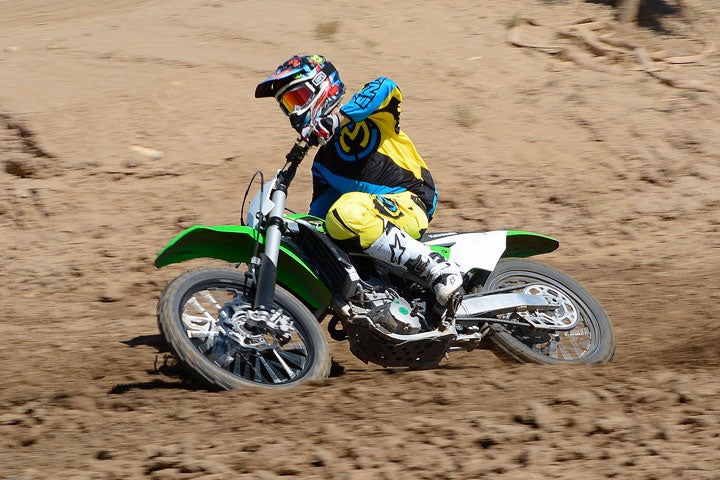


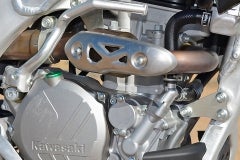
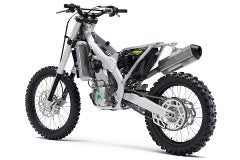
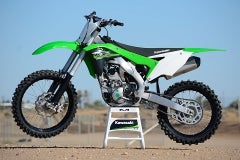


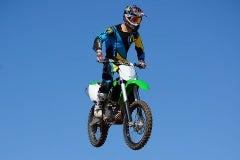




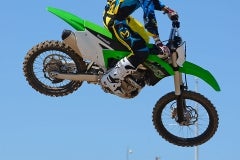

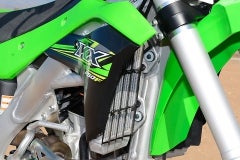
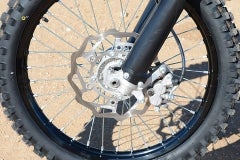
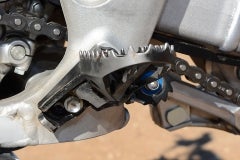
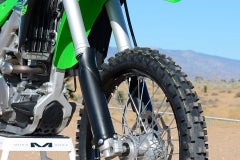
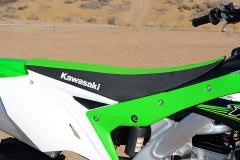
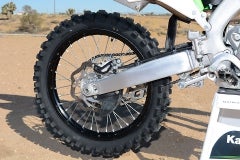
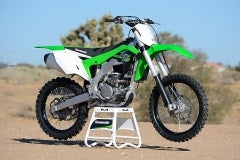
 Your Privacy Choices
Your Privacy Choices